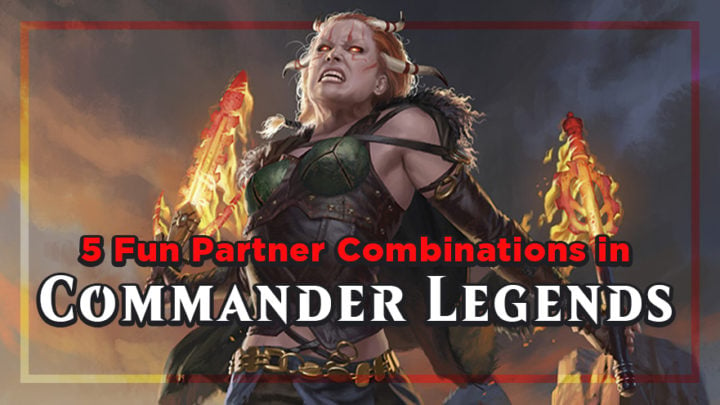Partner is back, and it’s more widespread than ever. Forty-one new partners are entering Commander, giving us more than 1300 new combinations of pairings. This is as incredible as it can be overwhelming, so I’ve done some of the hard work for you by finding some of the most fun combinations. I’ve picked out and detailed five of my favorite new partner combos to show you how diverse the options are; you’ll even see that the less efficient commanders at uncommon can make for some wild and awesome decks.
During my experiments to find these combos, I noticed a recurring theme among the new partner commanders. It seems there are two types of partners — primary and support — and this is reflected in most of my pairings. Some of the new generals are much more honed in on a specific game plan, which is what you’d usually aim to build your deck around. The others feel like their function is to help bolster those primary game plans, or even shore up weaknesses in them. This may be intentional from a game design perspective (or perhaps it’s partly down to my build style), but I appreciate how it helps to define a specific strategy while providing a secondary role. Whether that role comes in the form of a backup plan, support, or even an alternate win condition, it’s all down to the partners you choose.
Krark the Thumbless + Sakashima of a Thousand Faces – Thumb Storm/Headache Tribal

This unlikely pairing of a mysterious rogue and a goblin with poor fine motor skill is possibly my favorite partner combination in all of Magic. Krark’s ability lets you copy instants and sorceries, and Sakashima removes the legend rule while becoming a copy of Krark. You can use this combo to make a more traditional chaos deck, but I suggest looking into Copy Storm.
I’m sure you’ll agree that Krark’s Thumb is the perfect addition to any Krark the Thumbless deck, as it greatly reduces the chance of losing coin flips. You can run cards like Fabricate and Whir of Invention to grab it every game with ease.
But what if you could play even more Thumbs?
You could play with Krark’s Other Thumb if your playgroup will allow it, but two Thumbs just isn’t enough. Sakashima removes the legend rule, so you can play spells like Mirrormade to copy the legendary artifact and double the coin flips each time! Here’s how many flips you get with each Thumb:
- 1 Thumb: 2 coins
- 2 Thumbs: 4 coins
- 3 Thumbs: 8 coins
- 4 Thumbs: 16 coins
- 5 thumbs: 32 coins, etc…
You’re basically guaranteed to win each flip once you have three Thumbs on board (87.5% chance).
Next, you copy Krark! Cards like Quasiduplicate can make extra copies of our lucky goblin (and Krark might even let you copy the copy spells). Once you have a few clones on board, you can start casting instants and sorceries with reckless abandon! Let’s say you have Krark, Sakashima cloning Krark, another Krark copy, and three Thumbs. You cast Bonus Round, and three Krark triggers will go on the stack. Your Thumbs will let you rig the flips so that you can copy the spell with the first two triggers, then return it to hand with the last one. Now the next spell you cast will be copied twice, then copied up to three additional times! Imagine the possibilities when you cast Storm cards like Temporal Fissure!
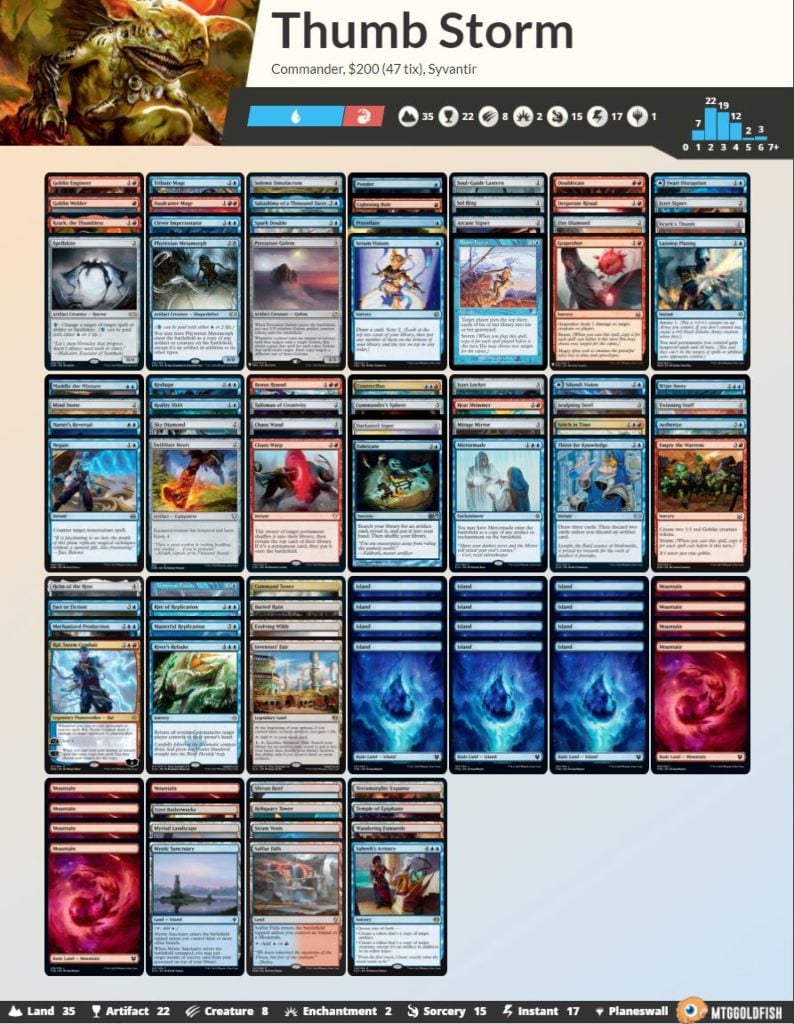
View full decklist
Buy this deck from Card Kingdom
That scenario obviously is Magical Christmas Land, but even if you don’t get to Storm off, you’ll be able to use your clone and copy effects for mischief. You can always run a much more simple alternate win condition, like a kicked Rite of Replication on a Precursor Golem.
Rograkh, Son of Rohgahh + Kediss, Emberclaw Familiar – The Little Voltron Deck That Could
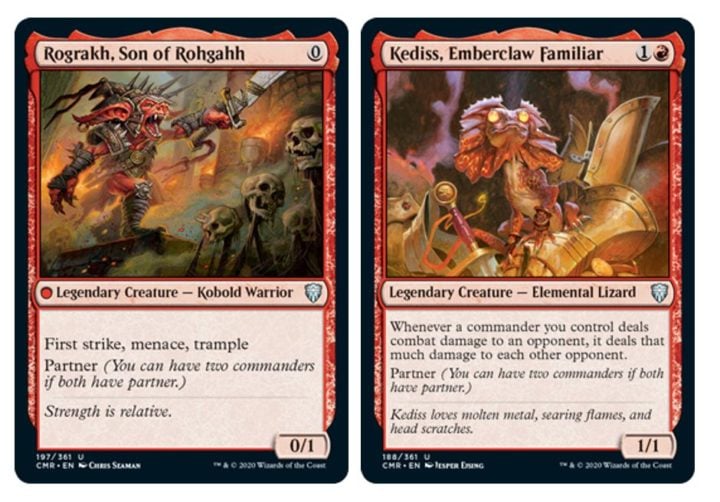
As soon as I saw Rograkh, Son of Rohgahh, I just knew they were going to be one of my favorite new commanders. They’re the very essence of unbridled rage, but they need a little help in expressing it. That’s why I think they’re best suited to jump into the fray alongside Kediss, Emberclaw Familiar. The cute Elemental Lizard can essentially triple Rograkh’s damage output, but three times zero is still zero…
My idea for this deck is to run plenty of equipment and auras, beef up Rograkh, and turn them into a serious threat. You can increase their power with cards like Loxodon Warhammer, help to protect them with Swiftfoot Boots, and even gain some value with Mask of Memory. Once they’re suited up, players will really start giving the little Kobold the respect they deserve. That’s when you’ll want to end the game quickly, as too much respect will put them back in the command zone!
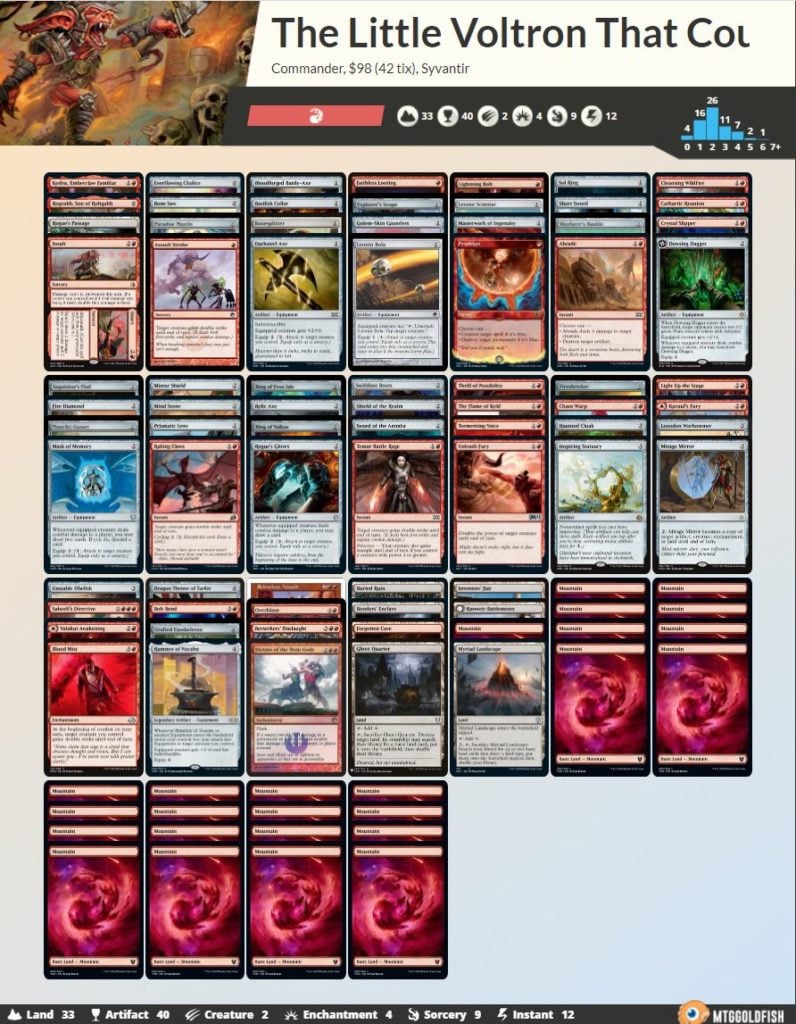
View full decklist
Buy this deck from Card Kingdom
There are a number of ways to help speed up your clock, and they’re all dependent on personal preference. You can add ways to give Rograkh double strike, like Temur Battle Rage and Berserkers’ Onslaught, or you could use damage doublers like Inquisitor’s Flail and Insult//Injury. You can even combine both options to great effect. If you don’t mind fighting dirty, you can even play Grafted Exoskeleton to infect the whole table in one swing while Kediss is out.
No matter what direction you take with this partnership, it will feel fantastic. You get to be the secretly lethal underdog, and you get your commander out every game on turn one. Everyone always roots for the little guy, and this pairing couldn’t be smaller!
Gilanra, Caller of Wirewood + Brinelin, the Moon Kraken – CMC6+ Tribal/Timmy’s Value Town

If there are two things Magic players love, it’s casting huge, splashy spells, and getting some good value. Gilanra, Caller of Wirewood and Brinelin, the Moon Kraken are perfectly matched to ensure you get both!
There’s an obvious common interest between the elf druid and their lunar friend: casting enormous spells. It’s often risky to tap out for expensive spells, however, especially when there are blue players at the table. Gilanra helps to minimize the risk by drawing you cards, and Brinelin will bounce problematic nonland permanents to help you control the board. As these are cast triggers, they will happen whether your spell gets countered or not. There’s also another way to help mitigate any risk in casting such mana-intensive spells: Cascade.
Imoti, Celebrant of Bounty is one of the best cards for ensuring you get value out of your spells, as it applies cascade to your 6+CMC cards. Sakashima’s Protege and Apex Devastator are also new cards from Commander Legends that could really pile on the advantage quickly. If you have a particular aversion to counterspells, you could even run cards like Destiny Spinner.
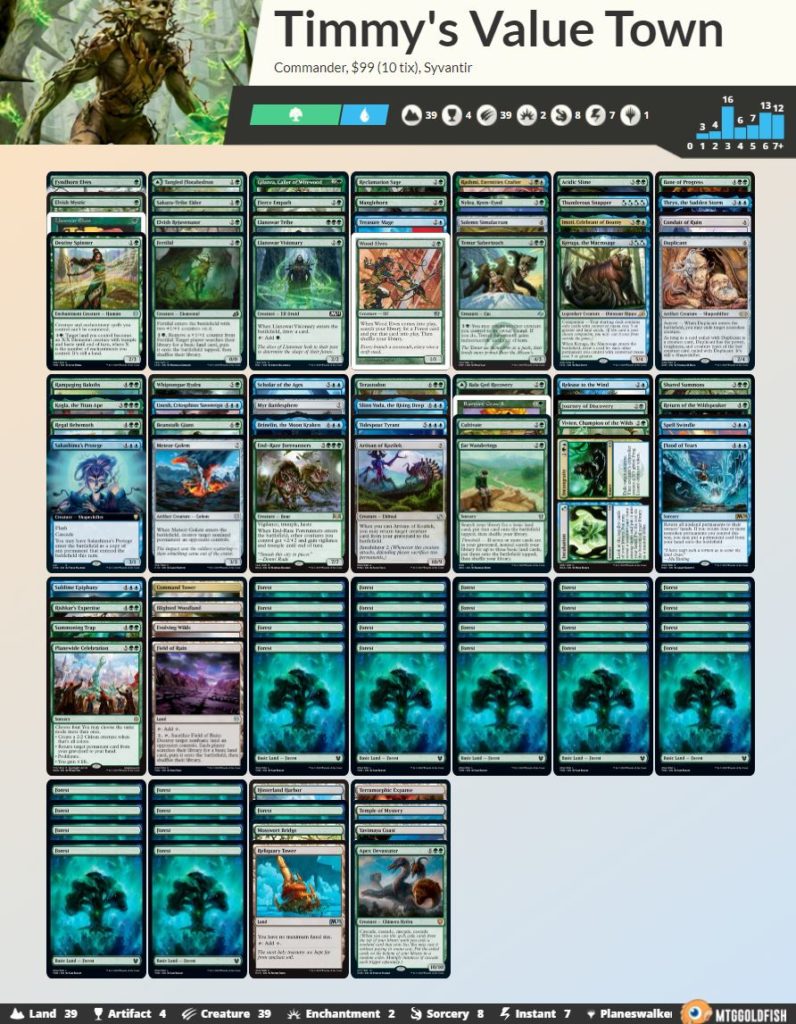
View full decklist
Buy this deck from Card Kingdom
This might seem like a fairly straightforward Simic ramp/value deck, but there are a number of ways to spice it up. You could focus on creatures with enter the battlefield triggers, like Meteor Golem and Kogla, the Titan Ape. You can then have Brinelin bounce them repeatedly with their cast trigger for a constant stream of removal. There are a whole host of tutors you can run to grab the right beast in your deck, too, like Fierce Empath and Treasure Mage. You could even avoid cheap spells altogether, and have Keruga, the Macrosage as your companion.
There might be more competitive Simic commanders out there, but the most interesting and memorable decks are always the unusual ones. Gilanra, Caller of Wirewood + Brinelin, the Moon Kraken is one of the more underappreciated pairings, but they have the potential to be some of the sweetest Timmy-style value commanders in Magic!
Dargo, the Shipwrecker + Jeska, Thrice Reborn – One-Punch Goblins
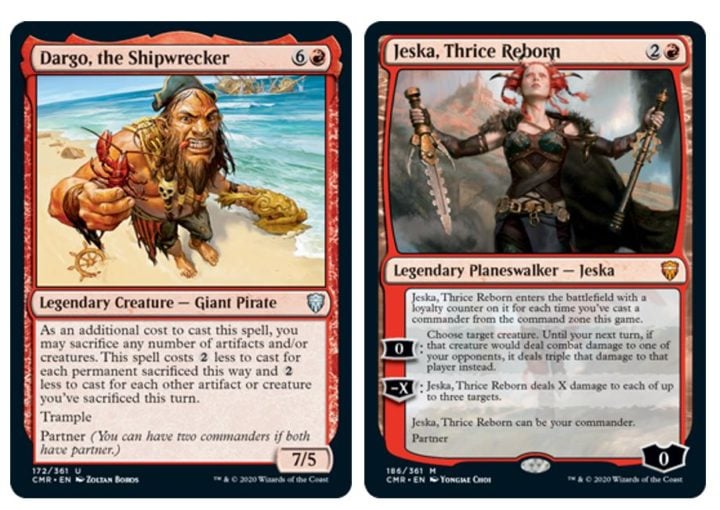
Dargo is a bold and fearsome pirate; his cost reduction is the only thing more impressive than his size. His swashbuckling nature might make you consider treasure as a way to take advantage of his abilities, but I propose a more interesting choice: Goblins!
Goblins are the quintessential sacrifice fodder — just take a look at Dragon Fodder if you’re not convinced. They are cheap, numerous, and love to be sacrificed; this makes them the ideal allies for Dargo. There are a number of goblin pirates, too, so it’s also a flavor win.
You can get immense value out of your little green friends in many different ways: you can destroy artifacts with Goblin Trashmaster, shoot down blockers with Pashalik Mons, or round up a new gang of recruits with Goblin Ringleader. Goblin Matron is the classic goblin tutor, allowing you to fetch the perfect goblin for any task, but the real star in this kind of build would be Skirk Prospector. Prospector serves as a sort of repeatable ritual effect when casting Dargo, as each goblin essentially pays for three mana of his casting cost. So we can accrue value and grind out games with our goblins, and we can call upon Dargo when we need a big beater. But there’s one more trick in this strategy…
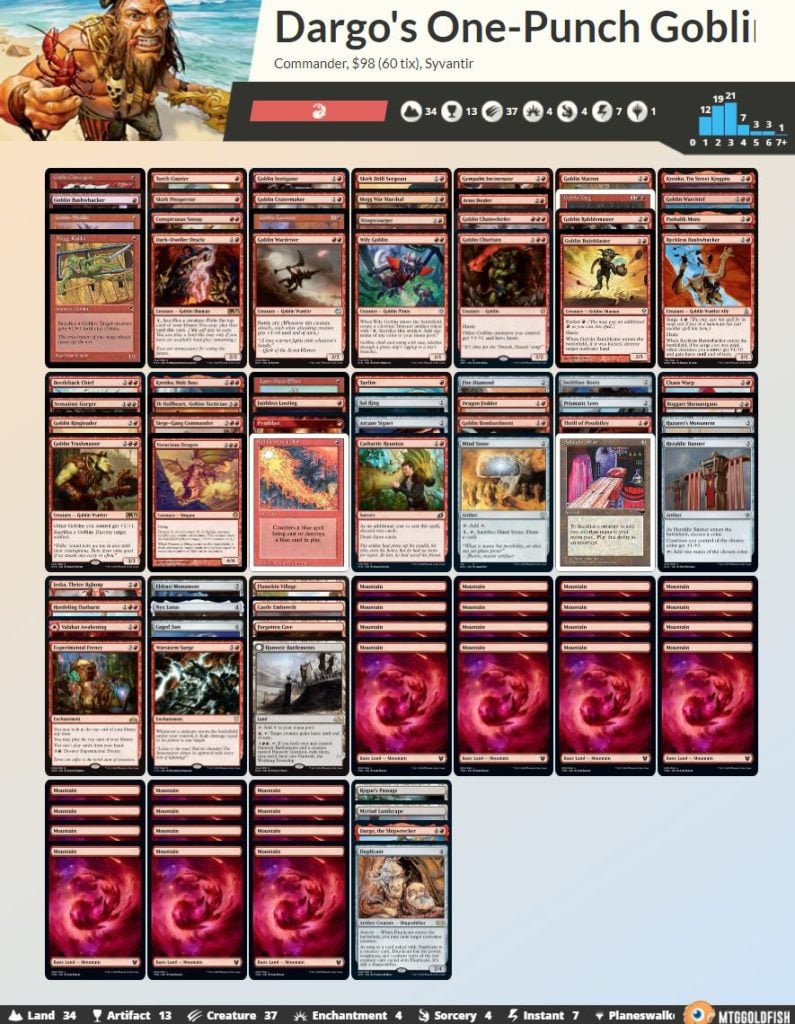
View full decklist
Buy this deck from Card Kingdom
Dargo, the Shipwrecker’s seven power is very relevant, as it only takes three direct hits from him to defeat someone with commander damage. Naturally, there’s no better partner to give this giant pirate than a planeswalker that can turn three hits into one!
Jeska, Thrice Reborn is an awesome planeswalker that slots right in with our goblin pirate team. She can remove some small creatures in a pinch, or more likely, she can make Dargo one-hit K.O. an opponent. You’d probably only cast her when you’re about to take out a player, as she doesn’t have much utility otherwise, but her triple damage ability is too good to pass up!
Other players will immediately figure out what you’re trying to do as both of your commanders will be visible from the start of the game, but that also means they have to worry about it for the whole game, too. This fear will often allow you to resolve more spells than usual, as it’d be wise of them to save that counterspell or removal for Dargo instead. Even if they do remove him, your goblin army is more than capable of powering him back out in no time at all — or just taking the game by themselves!
Ich-Tekik, Salvage Splicer + Rebbec, Architect of Ascension – Golem Tribal
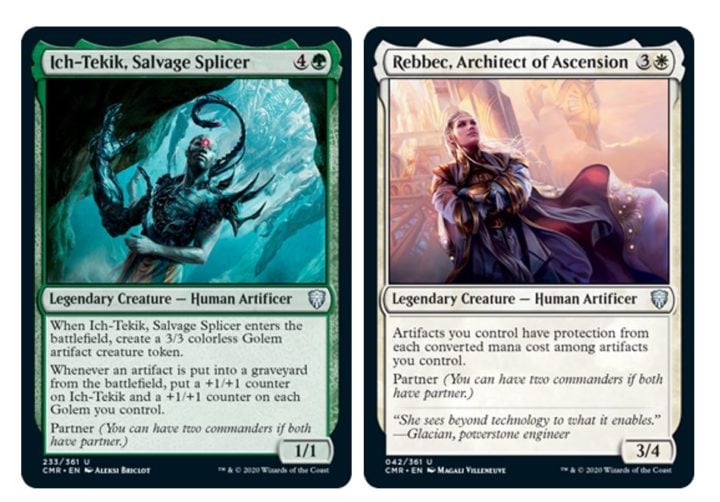
Golems are a bizarre tribe that never really had a dedicated commander. Players have certainly made golem-centred decks with commanders like Golos, Tireless Pilgrim, but “placeholder” commanders often don’t feel like they synergize with the deck. Ich-Tekik, Salvage Splicer is a fantastic new general that gives golem fans the artifact lord you’ve all been waiting for… in green?!
Naturally (pun intended), green isn’t exactly the color you associate with artifacts, and you really need white to be able to play the other Splicers. This is where Rebbec, Architect of Ascension comes in. She gives your golems incidental yet restricted protection, but as long as you have a few different artifacts out, they should be fairly safe.
The best creatures you can run are the aforementioned Splicers — a group of artificer cards that create a golem whenever they enter the battlefield, and provide a buff. These buffs range from Master Splicer’s “lord” effect to Vital Splicer’s regeneration, and will help to make your tokens into real threats. You can cast Splicer’s Skill over and over with any spare mana, and Golden Guardian can become a golem factory with little effort.
As all of the Splicers have great enter the battlefield abilities, you can flicker them with Eerie Interlude and Otherworld Journey to abuse the triggers. They can also protect against board wipes and removal in a pinch.
You can even lean into the +1/+1 counters subtheme to help grow your team to extraordinary sizes. Cards like Loyal Guardian and Ajani, the Greathearted become huge problems for your opponents, especially if you have a Conclave Mentor or Hardened Scales. Proliferate cards like Karn’s Bastion and Evolution Sage can really reinforce this plan, too, but we have another core tactic that can be even more effective.
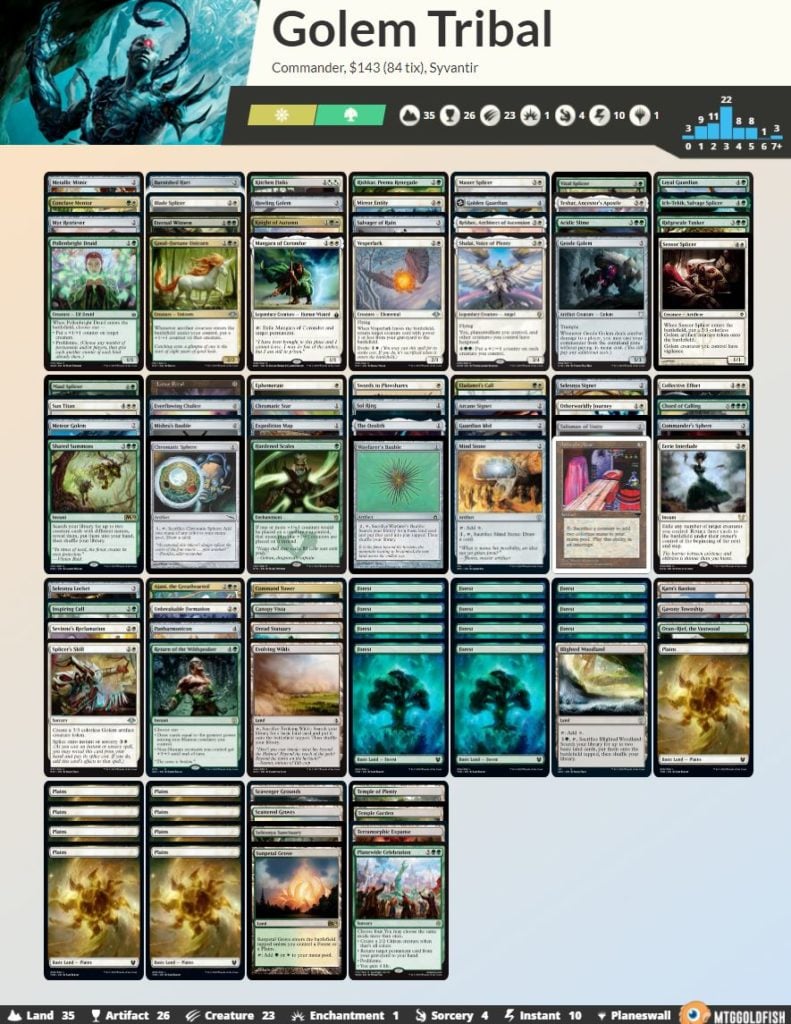
View full decklist
Buy this deck from Card Kingdom
In order to get the most out of your commanders, you need to run plenty of artifacts that you can easily sacrifice. Expedition Map, Mind Stone, and Burnished Hart are just a few examples of Commander staples with different converted mana costs that can hit the graveyard. Rebbec will protect your golems with them while they’re on the field, and Ich-Tekik can turn them into instant-speed Anthem effects when you sacrifice them for value. You could even run a small Teshar, Ancestor’s Apostle loop package to allow you to go infinite if needed, but cards like Scrap Trawler and Teshar are perfectly fine by themselves here, too.
This is a very unique pairing that can be taken in any number of different ways. Tokens, counters, blinking, and artifacts are all fun strategies, but it’s not often that they all work well together. If you’ve been meaning to build a few of these archetypes, this could kill several birds with one stone (or golem).
There’s no denying that Commander Legends has given us an abundance of boons. From much-needed reprints to new format staples, this set is shaping up to be both impactful and incredible. Many feared the return of the partner mechanic thanks to the effect it had on the format previously, but my only fear now is that I’ll have too many new decks to build!

Scott is an Irish content creator and the Head of Budget Magic for the Izzet League. He focuses on affordable decks in Pioneer, Modern, and Pauper, particularly ones that stray from the mainstream. When he’s not writing about his favorite decks, he can be found talking incessantly about them on Twitter and on The Budget Magic Cast.

